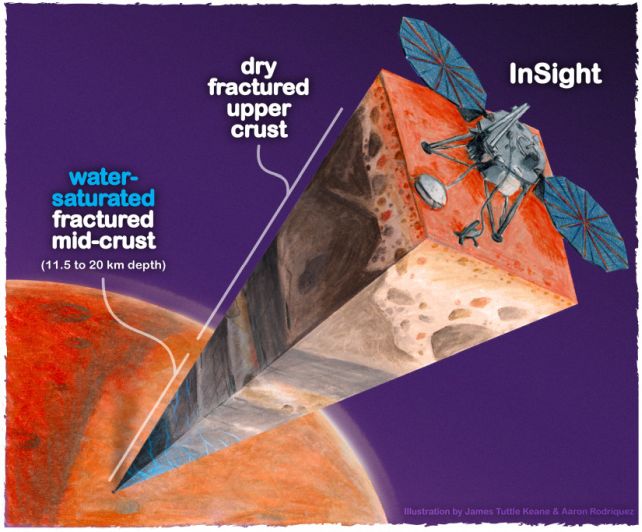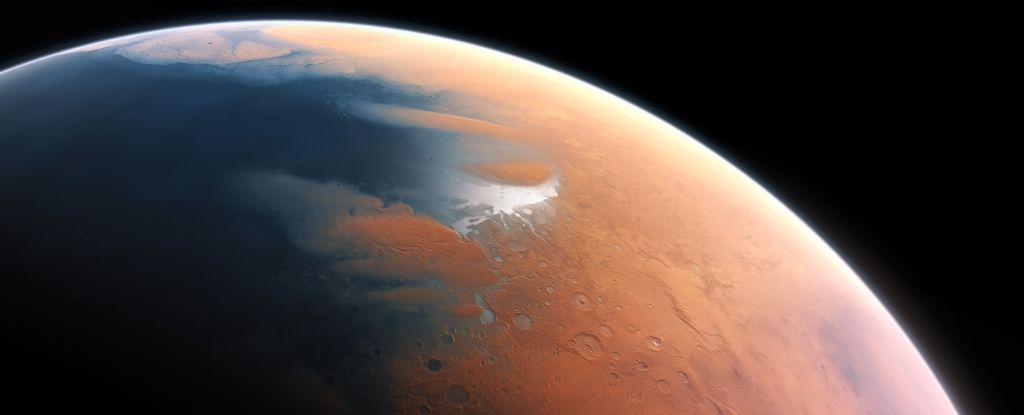Products You May Like
There are literal oceans’ worth of liquid water hiding out on Mars. There’s just one big problem. That water is actually in Mars, at depths that are too far below the surface for us to access.
That’s according to new analysis of seismic data collected by the Mars InSight lander, for which huge reservoirs of liquid water are the best explanation. And, although that water is out of reach, it is an important piece of the strange puzzle of the aquatic history of our dry, desiccated, dusty neighbor.
“Understanding the Martian water cycle is critical for understanding the evolution of the climate, surface and interior,” says geophysicist Vashan Wright of the University of California San Diego’s Scripps Institution of Oceanography.
“A useful starting point is to identify where water is and how much is there.”
As rovers scurry about on the surface of Mars, collecting data on its surface geology, it has become more and more evident that the red planet was once loaded with water. Minerals, terrain, and features such as ancient dry lake beds and deltas suggest that Mars was once pretty soggy.
There’s water on and just below the surface of Mars today, but only in the form of ice, and in quantities nowhere near high enough to account for the Martian wetness of eons past. In order to better understand the water history of Mars, knowing where the water went is crucial to understanding how much of it there could have been, billions of years ago.
There are two places the water could have gone: up into space as it evaporated into a gas, or down towards the Martian interior, sequestered either as ice deposits or liquid reservoirs. We have no way of measuring how much water leaked away into the wild black yonder, but we now have the data needed to probe the gooey center of Mars.
That’s thanks to the Mars InSight lander. It’s no longer operational, but between November 2018 and December 2022, it squatted, turtle-like, on the surface of Mars, monitoring the hums and rumbles of activity below.
Acoustic waves generated by seismic activity inside the planet change according to the density and composition of the material they are moving through. Scientists analyzing the data can make inferences about what that material might be based on the behavior of the seismic waves.
The researchers used a geophysical model identical to one used to map underground aquifers and oil fields here on Earth, and employed it to analyze data collected by InSight on Mars. They found that the data are best explained if, deep below the surface of Mars, there lies a layer of fractured igneous rock, such as granite, whose cracks are filled with liquid water.

That layer sits at depths between 11.5 and 20 kilometers (7.1 to 12.4 miles), so it’s probably not going to be accessible to humans when we eventually pop over to Mars for afternoon tea and a cupcake. But it’s tantalizing, nevertheless. Not only does it give us a new tool for understanding the Martian water cycle, it suggests that Mars retained a lot of its water, with implications for Mars’ potential habitability past and present.
“Establishing that there is a big reservoir of liquid water provides some window into what the climate was like or could be like,” says geophysicist Michael Manga of University of California, Berkeley.
“And water is necessary for life as we know it. I don’t see why [the underground reservoir] is not a habitable environment. It’s certainly true on Earth – deep, deep mines host life, the bottom of the ocean hosts life. We haven’t found any evidence for life on Mars, but at least we have identified a place that should, in principle, be able to sustain life.”
Mars continues to be coy about its water reserves. Previous detections identified, and then raised serious questions about water reservoirs lurking below the Martian surface. And InSight data has shown that there’s not likely to be much water ice in the upper crust around the lander’s location.
But if the water-rich layer now detected deeper below the surface were consistent around the entire globe of Mars, there would be enough water to fill ancient oceans, and then some, the researchers found.
Of course, the findings are not conclusive. To learn more about what Mars is keeping hidden beneath its dusty surface, we’ll need further and better observations and analysis of Mars’ crust. Maybe it’s time to consider a new seismometer?
Just a thought.
The research has been published in the Proceedings of the National Academy of Sciences.
